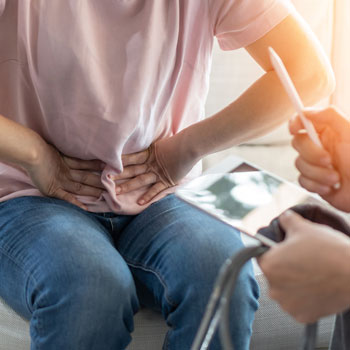5 Signs That You Might Need Gallbladder Surgery

Answer a few questions and we'll provide you with a list of primary care providers that best fit your needs.
Unless you’ve felt the stabbing pain of gallstones, most likely you’ve never given your gallbladder a second thought. But this small organ can trigger big problems. Learn the signs and symptoms of gallbladder trouble, and when it’s time to seek a surgeon’s advice.
What Is the Gallbladder And What Does It Do?
The gallbladder is a small, pouchlike organ in the upper right part of your abdomen (belly). The gallbladder collects and stores bile, a fluid produced by the liver that helps break down fatty foods.
Why Does Your Gallbladder Need To Be Removed?
You may need gallbladder surgery if you have pain or other symptoms caused by gallstones — small stones that can form in the gallbladder. They can block the flow of bile and irritate the gallbladder. Common symptoms of gallbladder problems include:
- Indigestion, with bloating, heartburn, and gas
- Sharp pain in your belly
- Nausea and vomiting
- Fever
- Yellowing of the skin and the whites of the eyes (jaundice)
The good news? You don’t need a gallbladder to live, so if it’s causing severe problems, your doctor will likely recommend surgery to remove it.
You may need gallbladder surgery if you have pain or other symptoms caused by gallstones.
How Is the Gallbladder Removed?
 There are two ways of removing the gallbladder. Both are performed under general anesthesia, which means you’ll be asleep and pain-free during the operation. Talk with your health care provider about which one is right for you:
There are two ways of removing the gallbladder. Both are performed under general anesthesia, which means you’ll be asleep and pain-free during the operation. Talk with your health care provider about which one is right for you:
- Laparoscopic (keyhole) cholecystectomy (gallbladder removal): This is the most common way to remove the gallbladder.
- The surgeon makes several small incisions, or cuts, in your abdomen. She then inserts a laparoscope — a thin, lighted tube that lets her see inside your belly — through one of the cuts.
- Other medical instruments, including a tiny camera, are inserted through the other cuts. Gas is pumped into your belly to expand the space, so your surgeon has more room to see and work.
- The gallbladder is removed using the laparoscope and other instruments. The surgeon closes the incisions with small stitches, staples, surgical tape, or glue. These will disappear as you heal, so your doctor won’t have to remove them later. With this method, you can leave the hospital sooner and recover faster.
- Open cholecystectomy: In some cases, laparoscopic gallbladder removal may not be possible. Reasons include severe gallbladder problems or scar tissue in the abdomen from earlier surgery. With open surgery, your surgeon will make a single, larger incision in your belly to access and remove your gallbladder. She will then close the incision with stitches and cover it with a dressing.
Sometimes a laparoscopic procedure turns into an open one during the operation if your surgeon can’t see your gallbladder clearly or remove it safely. If you’re scheduled for a laparoscopy, talk with your doctor ahead of time about the risk of it becoming an open procedure.
What Are the Risks of Gallbladder Removal?
Gallbladder removal surgery is considered a standard, safe procedure. Complications of laparoscopic surgery are rare. But, like any type of surgery, there’s a risk of complications, which can include:
- Bleeding
- Infection in the surgery area
- Blood clots
- Bile leakage
- Heart problems
- Hernias (when a small amount of your gut, or intestine, or other tissue bulges through the muscles that cover it)
Ask your doctor about the benefits and risks of surgery before your operation.
How Long Does It Take To Recover From Gallbladder Surgery?
Your recovery time will depend on which procedure you had.
- Laparoscopic: Most people can leave the hospital on the same day or the day after the operation. If you leave that day, have someone stay with you for at least 24 hours as you may still be feeling the effects of the anesthesia. You’ll likely be able to return to your normal activities in about two weeks.
- Open: Usually you’ll have to stay in the hospital for three to five days afterwards. Recovery takes about six to eight weeks.
Answer a few questions and we'll provide you with a list of primary care providers that best fit your needs.
Sources: National Health Service; Society of American Gastrointestinal and Endoscopic Surgery; Medline Plus




